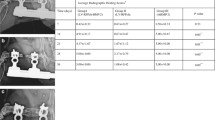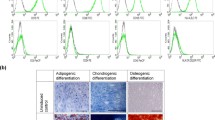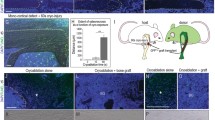Abstract
Purpose
Osteogenesis imperfecta is a serious genetic disorder that results from improper type I collagen production. We aimed to evaluate whether bone marrow stromal cells (BMSC) delivered locally into femurs were able to engraft, differentiate into osteoblasts, and contribute to formation of normal bone matrix in the osteogenesis imperfect murine (oim) model.
Methods
Donor BMSCs from bone-specific reporter mice (Col2.3GFP) were expanded in vitro and transplanted into the femoral intramedullary cavity of oim mice. Engraftment was evaluated after four weeks.
Results
We detected differentiation of donor BMSCs into Col2.3GFP+ osteoblasts and osteocytes in cortical and trabecular bone of transplanted oim femurs. New bone formation was detected by deposition of dynamic label in the proximity to the Col2.3GFP+ osteoblasts, and new bone showed more organized collagen structure and expression of type I α2 collagen. Col2.3GFP cells were not found in the contralateral femur indicating that transplanted osteogenic cells did not disseminate by circulation. No osteogenic engraftment was observed following intravenous transplantation of BMSCs. BMSC cultures derived from transplanted femurs showed numerous Col2.3GFP+ colonies, indicating the presence of donor progenitor cells. Secondary transplantation of cells recovered from recipient femurs and expanded in vitro also showed Col2.3GFP+ osteoblasts and osteocytes confirming the persistence of donor stem/progenitor cells.
Conclusion
We show that BMSCs delivered locally in oim femurs are able to engraft, differentiate into osteoblasts and osteocytes and maintain their progenitor potential in vivo. This suggests that local delivery is a promising approach for introduction of autologous MSC in which mutations have been corrected.





Similar content being viewed by others
References
Rauch F, Glorieux FH (2004) Osteogenesis imperfecta. Lancet 363:1377–1385
Chamberlain JR, Schwarze U, Wang PR, Hirata RK, Hankenson KD, Pace JM, Underwood RA, Song KM, Sussman M, Byers PH, Russell DW (2004) Gene targeting in stem cells from individuals with osteogenesis imperfecta. Science 303:1198–1201
Prockop DJ, Oh JY (2012) Medical therapies with adult stem/progenitor cells (MSCs): a backward journey from dramatic results in vivo to the cellular and molecular explanations. J Cell Biochem 113:1460–1469
Boban I, Jacquin C, Prior K, Barisic-Dujmovic T, Maye P, Clark SH, Aguila HL (2006) The 3.6 kb DNA fragment from the rat Col1a1 gene promoter drives the expression of genes in both osteoblast and osteoclast lineage cells. Bone 39:1302–1312
Boban I, Barisic-Dujmovic T, Clark SH (2010) Parabiosis model does not show presence of circulating osteoprogenitor cells. Genesis 48:171–182
Wang LP, Liu YL, Kalajzic Z, Jiang X, Rowe DW (2005) Heterogeneity of engrafted bone-lining cells after systemic and local transplantation. Blood 106:3650–3657
Vanleene M, Saldanha Z, Cloyd KL, Jell G, Bou-Gharios G, Bassett JHD, Williams GR, Fisk NM, Oyen ML, Stevens MM, Guillot PV, Shefelbine SJ (2011) Transplantation of human fetal blood stem cells in the osteogenesis imperfecta mouse leads to improvement in multiscale tissue properties. Blood 117:1053–1060
Guillot PV, Abass O, Bassett JH, Shefelbine SJ, Bou-Gharios G, Chan J, Kurata H, Williams GR, Polak J, Fisk NM (2008) Intrauterine transplantation of human fetal mesenchymal stem cells from first-trimester blood repairs bone and reduces fractures in osteogenesis imperfecta mice. Blood 111:1717–1725
Panaroni C, Gioia R, Lupi A, Besio R, Goldstein SA, Kreider J, Leikin S, Vera JC, Mertz EL, Perilli E, Baruffaldi F, Villa I, Farina A, Casasco M, Cetta G, Rossi A, Frattini A, Marini JC, Vezzoni P, Forlino A (2009) In utero transplantation of adult bone marrow decreases perinatal lethality and rescues the bone phenotype in the knockin murine model for classical, dominant osteogenesis imperfecta. Blood 114:459–468
Pereira RF, O'Hara MD, Laptev AV, Halford KW, Pollard MD, Class R, Simon D, Livezey K, Prockop DJ (1998) Marrow stromal cells as a source of progenitor cells for nonhematopoietic tissues in transgenic mice with a phenotype of osteogenesis imperfecta. Proc Natl Acad Sci USA 95:1142–1147
Otsuru S, Gordon PL, Shimono K, Jethva R, Marino R, Phillips CL, Hofmann TJ, Veronesi E, Dominici M, Iwamoto M, Horwitz EM (2012) Transplanted bone marrow mononuclear cells and MSCs impart clinical benefit to children with osteogenesis imperfecta through different mechanisms. Blood 120:1933–1941
Horwitz EM, Prockop DJ, Fitzpatrick LA, Koo WW, Gordon PL, Neel M, Sussman M, Orchard P, Marx JC, Pyeritz RE, Brenner MK (1999) Transplantability and therapeutic effects of bone marrow-derived mesenchymal cells in children with osteogenesis imperfecta. Nat Med 5:309–313
Horwitz EM, Prockop DJ, Gordon PL, Koo WW, Fitzpatrick LA, Neel MD, McCarville ME, Orchard PJ, Pyeritz RE, Brenner MK (2001) Clinical responses to bone marrow transplantation in children with severe osteogenesis imperfecta. Blood 97:1227–1231
Horwitz EM, Gordon PL, Koo WK, Marx JC, Neel MD, McNall RY, Muul L, Hofmann T (2002) Isolated allogeneic bone marrow-derived mesenchymal cells engraft and stimulate growth in children with osteogenesis imperfecta: implications for cell therapy of bone. Proc Natl Acad Sci USA 99:8932–8937
Kalajzic I, Kalajzic Z, Kaliterna M, Gronowicz G, Clark SH, Lichtler AC, Rowe D (2002) Use of type I collagen green fluorescent protein transgenes to identify subpopulations of cells at different stages of the osteoblast lineage. J Bone Miner Res 17:15–25
Saban J, King D (1996) PCR genotyping of oim mutant mice. Biotechniques 21(190):192
Roguljic H, Matthews BG, Yang W, Cvija H, Mina M, Kalajzic I (2013) In vivo identification of periodontal progenitor cells. J Dent Res 92:709–715
Roberts-Pilgrim AM, Makareeva E, Myles MH, Besch-Williford CL, Brodeur AC, Walker AL, Leikin S, Franklin CL, Phillips CL (2011) Deficient degradation of homotrimeric type I collagen, alpha 1 (I)(3) glomerulopathy in oim mice. Mol Genet Metab 104:373–382
Uveges TE, Kozloff KM, Ty JM, Ledgard F, Raggio CL, Gronowicz G, Goldstein SA, Marini JC (2009) Alendronate treatment of the brtl osteogenesis imperfecta mouse improves femoral geometry and load response before fracture but decreases predicted material properties and has detrimental effects on osteoblasts and bone formation. J Bone Miner Res 24:849–859
Cabral WA, Marini JC (2004) High proportion of mutant osteoblasts is compatible with normal skeletal function in mosaic carriers of osteogenesis imperfecta. Am J Hum Genet 74:752–760
Le Blanc K, Gotherstrom C, Ringden O, Hassan M, McMahon R, Horwitz E, Anneren G, Axelsson O, Nunn J, Ewald U, Norden-Lindeberg S, Jansson M, Dalton A, Astrom E, Westgren M (2005) Fetal mesenchymal stem-cell engraftment in bone after in utero transplantation in a patient with severe osteogenesis imperfecta. Transplantation 79:1607–1614
Jones GN, Moschidou D, Lay K, Abdulrazzak H, Vanleene M, Shefelbine SJ, Polak J, de Coppi P, Fisk NM, Guillot PV (2012) Upregulating CXCR4 in human fetal mesenchymal stem cells enhances engraftment and bone mechanics in a mouse model of osteogenesis imperfecta. Stem Cells Transl Med 1:70–78
Kalajzic Z, Li H, Wang LP, Jiang X, Lamothe K, Adams DJ, Aguila HL, Rowe DW, Kalajzic I (2008) Use of an alpha-smooth muscle actin GFP reporter to identify an osteoprogenitor population. Bone 43:501–510
Li F, Wang X, Niyibizi C (2010) Bone marrow stromal cells contribute to bone formation following infusion into femoral cavities of a mouse model of osteogenesis imperfecta. Bone 47:546–555
Pignolo RJ, Kassem M (2011) Circulating osteogenic cells: implications for injury, repair, and regeneration. J Bone Miner Res 26:1685–1693
Acknowledgments
This work has been supported by NIH/NIAMS grant AR055607 to I.K and a Fellows Research Award by Connecticut Children’s Medical Center to P.P. We would like to thank Dr. Charlotte Phillips, University of Missouri–Columbia for providing the collagen type I α2 chain antibody.
Author information
Authors and Affiliations
Corresponding author
Rights and permissions
About this article
Cite this article
Pauley, P., Matthews, B.G., Wang, L. et al. Local transplantation is an effective method for cell delivery in the osteogenesis imperfecta murine model. International Orthopaedics (SICOT) 38, 1955–1962 (2014). https://doi.org/10.1007/s00264-013-2249-y
Received:
Accepted:
Published:
Issue Date:
DOI: https://doi.org/10.1007/s00264-013-2249-y




